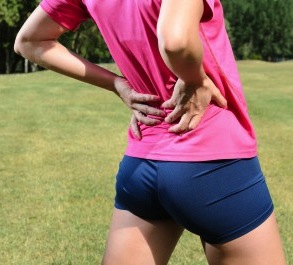Five Core Exercises for Your Lower Back

Treating and Preventing Low Back Pain
Low back pain strikes without prejudice. From afternoon athletes to computer nerds, low back pain symptoms afflict people from all walks of life. In fact, up to 80% of people have suffered from this condition. Every day, in every orthopaedic Physical Therapy center, someone is being treated for low back pain.
In most cases, Physical Therapists can determine the cause and formulate a rehabilitation program aimed at eliminating the symptom and preventing its return. A low back rehabilitation treatment programs commonly includes a thorough exercise program designed to develop strength throughout the core musculature.
Strengthening Your Core
Your Core can be thought of as the “foundation” of the body. Every muscle that attaches to the spine and the pelvis extending from the shoulder blades to the knees should be considered to be part of the Core musculature. The musculature must be looked at as a unit. The ability for one muscle to contract might have an effect on the surrounding musculature, thus impacting the whole system.
As a result, treating pain in one muscle, involves treating the whole system. A Core training program utilizes exercises that can enhance these muscles’ capability to move and stabilize the joints of the spine.
Understanding the Core
There are small muscles in front of the pelvis directly below the abdominal muscles that are the very first muscles to contract during any body movement. These muscles (Transverse Abdominal muscles) are less active in someone who experiences low back pain. The pelvic floor muscles (the muscles that stop urine flow) are active during movement in a non-symptomatic patient. Finally, the deepest muscles of the low back (Multifidus) are active during movement of a non-symptomatic person. These muscles are thought to stabilize the spine and pelvis and act as a “sleeve” around the vertebrae.

Think about it this way. If you put a “sleeve” over a child’s building blocks, the blocks can be moved as a unit. If the “sleeve is removed, the blocks are scattered when you attempt to move them. Applied to your body, it looks like this:
The muscular “sleeve” around the vertebrae enables the larger, more superficial muscles to move the vertebrae as a unit. If the muscular “sleeve” is not active due to pain, the larger muscles may move the vertebrae but not as a unit, causing more instability. This instability can result in pain, stiffness, inflammation and more.
A Core training program addresses all of the muscles at the same time. Any muscle that is too weak or in-active can have a direct or in-direct effect on the status of the Lumbar Spine and eventually cause pain.
Perform Core Exercises Regularly
There are several basic strengthening exercises that should be performed on a daily basis. These exercises can benefit your Core (and low back) in the following ways:
- Engage every muscle of the Core
- Stimulate blood flow to the area
- Increase the neuromuscular activity (the nervous system controls the muscles)
- Build strength and endurance in Core muscles over time (needed to be able to generate low grade force throughout the day)
Five Core Exercises
These exercises should be performed daily for the first 3-4 weeks. The frequency can be reduced to 3-4x/week after the initial training period. The maintenance program of these exercises enables the body to be better prepared for life’s activities and avoid the onset of low back pain. Most low back pain can be prevented with a proper posture, body mechanics and a thorough exercise routine.
1. Superman: Lie prone (on your stomach) with your arms outstretched overhead. Slowly raise one arm and the opposite leg. Pause and then lower the arm and leg down. Repeat 15x on each side.
2. Bridge: Lie on your back (supine) and bend your knees, so your feet are flat on the floor. Contract your stomach muscles and try to move your belly button towards the floor. Slowly raise your buttocks off of the floor. Pause for 2 seconds at the top and be as still/stable as possible. Lower to the floor and repeat the sequence 15x.
3. Plank: Lie prone (on your stomach) and push yourself up off of the floor. Support your body weight on your forearms, elbows and toes. No other body part should touch the floor during the exercise. If it is too hard to support your body weight this way, you may allow your knees to touch the floor. The position should be held for 5-30 seconds or longer. Perform this exercise 3-5 x.
4. Side Plank: Lie on one side. Push your body weight up off of the floor and support it with our forearm and elbow on the side where you are lying. The side of your foot rests on the floor during the exercise routine. If this position is too difficult, keep the entire side of your leg below the knee on the floor during the exercise. Hold the position 5-30 seconds or longer. Perform this exercise 3-5x.
5. Squat: Stand in front of a chair as if you are going to sit down. Your feet should be shoulder width apart. Begin to “sit” down slowly and barely touch your buttocks to the chair seat. Return to an erect/standing position. As you lower yourself downward, your chest and head should be held upward as you “stick out” your buttocks. Don’t allow your kneecaps to move too far forward or beyond your toes. Don’t use your hands to assist the motion in either direction unless it is too difficult to perform. Repeat this routine 15x.
Tips for Optimizing Core Exercises
-
- Perform all exercises slowly and be able to “stabilize” and “hold” the position that is most difficult when the muscles are “working” their hardest.
- If you cannot complete 15 continuous repetitions of an exercise, do 3 sets of 5 repetitions to begin and progress as you get stronger.
- Adding stretches and cardiovascular exercise will compliment the strengthening exercises nicely.
- Perform these exercises daily even when you are in pain. It is natural to have a slight amount of increased pain at the beginning of the exercise program.
- If back pain persists for more than a few days, see your Physical Therapist.
*As always it is important to get clearance from your doctor prior to beginning any exercise program. Any exercise or stretch could cause injury if performed incorrectly.


























Hi,I log on to your blogs named “Five Core Exercises for Your Lower Back” on a regular basis.Your story-telling style is witty, keep it up! And you can look our website about proxy list.
i have lower right back pain for 2-3 months now getntig worse over time and in a weeks times it went from a muscle type pain to a pinched nerve kind simialr to a kinked neck but in my back and lot more intense. it sometimes radiates to my thigh it’s not sciatic but something else any idea whats wrong with me and what can i do about it? btw the stretch helped a lil
Hello there! I could have sworn I’ve been to this website before but after browsing through some of the post I realized it’s new to me.
Nonetheless, I’m definitely delighted I found it and I’ll be book-marking and checking back frequently!
Great article, with so many people affected by low back pain it is important for everyone to understand the importance of the “core”. I really liked how the article described the core muscles as a “sleeve” to help protect the spine. With chronic low back pain local muscles, such as transverse abdomins, multifidus (TrA) and pelvic floor, atrophy causing increase pain and segment mobility. Like mentioned in the article the Transverse Abdominis is a very important local muscle and acts as a body’s natural corset; starting from the (back) iliac crest and thoracolumbar fascia to the (front) linea alba and xiphoid proecss. The multifidus is a deep spinal muscle that originates at the sacrum and pelvis and inserts onto the spinous process of the vertebrae.
When initiating stabilization exercise progressions it is important to always start with local segmental control. Activating TrA and multifidus with isometric contractions and integrating low level contraction with normal breathing patterns should be done prior to using global muscles such as abdominals and glutes. One the patient feels confident with local contractions activities should be progressed from laying to sitting to standing activities. It is important to emphasize local contraction prior to performing any exercise or activity to ensure spinal stability.
It is important to note that even when low back pain symptoms subside, local muscle systems may still not function properly resulting in increase segmental mobility and recurrence of back symptoms. This is why it is so important to educate patients about the use of local core muscles and ensuring proper progression of exercises include core activation.
Source I used are as following if you are interested in further investigation:
Richardson CA, Hodges PW, Hides JA, Therapeutic Exercises for Lumbopelvic Stabilization: A Motor Control Approach for the Treatment and Prevention of Low Back Pain, 2nd ed. Edinburgh, Churchill Livingstone, 2004.
O’Sullivan SB, Schmitz TJ. Physical Rehabilitation, 5th ed. Philadelphia: FA Davis, 2007.
bana türkçesini yollarmısnız ? bu egsersizin